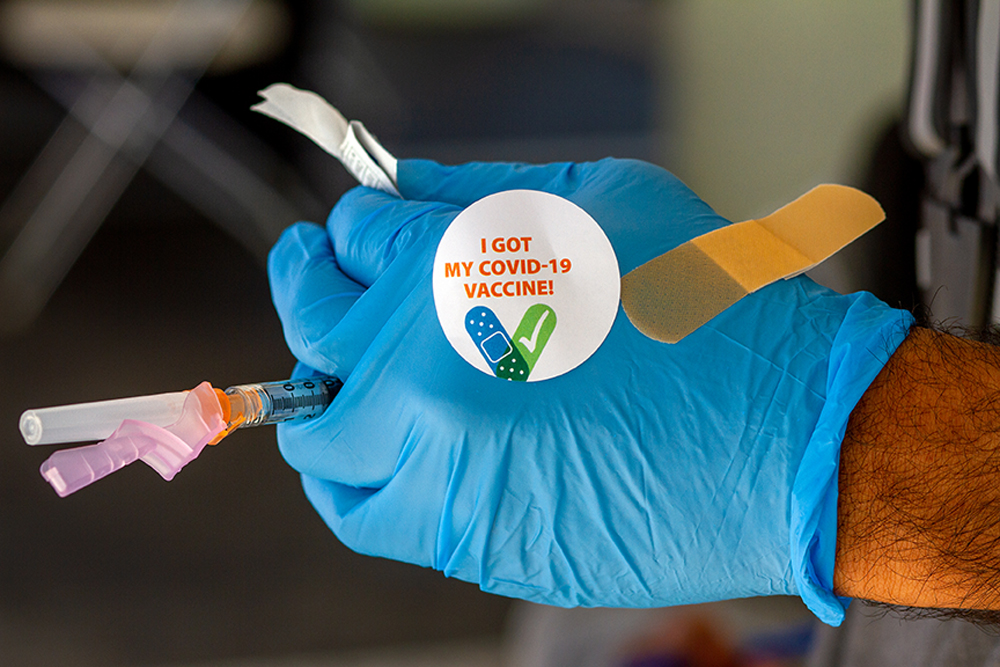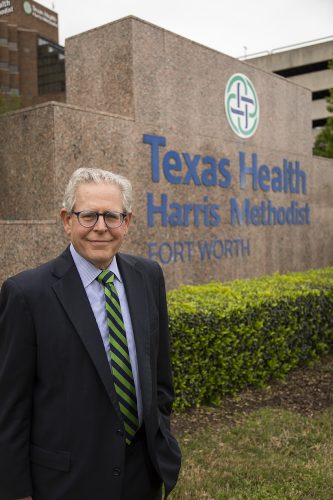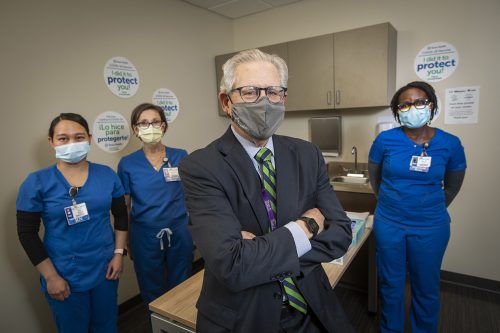
Photo by Joyce Marshall
Barclay Berdan Leads the Covid Vaccination Effort in DFW
The Texas Health Resources CEO is a case study in crisis leadership.
Earlier this year, state health officials tapped the hospital system of Barclay Berdan ’76 as command central for inoculating Tarrant County against the coronavirus. The monumental preparation and crowd coordination may be unparalleled in modern health care.

In the last six years, Barclay Berdan has seen Fort Worth’s health ranking in the Gallup National Health and Well-Being Index move from No. 185 to No. 31. Photo by Rodger Mallison
Berdan, CEO of Arlington-based Texas Health Resources, already was at the helm in a mission-critical role: He leads 23,000 employees across 350 locations and keeps tabs on $5 billion in operating revenue.
The pandemic expanded those responsibilities, requiring decisions such as temporarily stationing a refrigerated mobile morgue outside one of his hospitals.
In what would seem like the busiest time of his career, Berdan is eager to link with people. These conversations energize him. But lately he has answered calls from folks who apologize for interrupting him.
“They’ll say, ‘I know you’re really busy, and I don’t want to take a lot of time,’ and I’m thinking, ‘I haven’t had anybody to talk to in the last hour.’ ”
Berdan’s responsibilities juxtaposed with a natural desire to connect make for a solid leadership case study.
Suzanne Carter, executive director of the Executive MBA Program in the Neeley School of Business, doesn’t know Berdan personally but has built a career helping people explore high-performing leadership. In a crisis, Carter said, leaders must recognize what decision needs to be made and how their values can help drive it.
“The other variable in the equation is: What experience does that leader have with this type of situation?” she said.
Berdan came of age professionally during some of the most transformative episodes in the nation’s health care history. Those experiences, dovetailed with a calm demeanor and a leadership style that emphasizes listening over barking out orders, are helping him face Covid.
Developing a Career
Berdan grew up in Oak Park, Illinois, a working-class Chicago suburb. He graduated from TCU a few years after Congress passed the Health Maintenance Organization Act in 1973 with hopes of curtailing soaring health care costs. Employers were required to offer workers access to networks of providers who agreed to lower rates for members.
With a TCU degree in biology in hand, Berdan returned to the Midwest for an MBA from the University of Chicago, specializing in hospital administration.
“I’ve had a habit of thinking and asking about the inputs, outputs and how can I make it perform better or be different.”
Barclay Berdan
The ever-changing health care industry played to his childhood strength of taking things apart to learn how they operate. He’s a self-described analytical thinker who tries to see problems from various vantage points.
“I’ve always tended to think of how systems work,” he said. “I’ve had a habit of thinking and asking about the inputs, outputs and how can I make it perform better or be different.”
Berdan worked in administrative positions at hospitals in Illinois, Florida, Arkansas and eventually Texas. During that time, Medicare spending rose from $36.8 billion in 1980 to $72.3 billion in 1985 to $111 billion in 1990, reports the Institute for Policy Innovation.
In response, the government implemented more pricing controls on diagnostic groups. Essentially, a fixed price would be assigned for each diagnosis.
Those changes created career-defining opportunities for Berdan. He would represent a new breed of hospital executives armed with enough business savvy to restructure operations for greater bargaining power against insurers.
Building a Network
By the 1990s, he was ascending at Fort Worth’s Harris Methodist Hospital System. North Texas then was home to more than 5 million people, and Dallas-Fort Worth had the largest growth rate in the nation at 29.3 percent between 1990 and 2000.
Across town, Douglas Hawthorne, an administrator with Presbyterian Healthcare Resources, was orchestrating a plan to merge assets with Harris Methodist. He would need Berdan’s organizational expertise to pull it off.
Nationwide, hospitals in the 1990s were consolidating in response to the rapid growth of managed care — a delivery system organized to control costs and improve quality.
North Texas was poised for hospital consolidation because the population boom had created explosive growth in the outlying areas. Hawthorne noticed suburban patients navigating fractured health care with disparate hospitals and clinics. Consolidation also could strengthen negotiations with insurance companies, which were increasingly pressing for lower costs.
Hawthorne’s plan worked. In 1997, the combined assets of Presbyterian Healthcare and Harris Methodist created a new system, Texas Health Resources. Arlington Memorial Hospital joined the system later that year.
Berdan helped establish Texas Health Resources as the largest health system in North Texas based on patient beds and annual revenue. He served as president of Texas Health Harris Methodist Hospital Fort Worth, then moved through a series of higher system-level positions.
In 2005, he was named executive vice president of the health system. Two years later he became senior executive vice president, with responsibility for aligning all of the hospitals for greater efficiency and standardizing performance. In 2012, he was appointed Texas Health’s chief operating officer.
Within the tight national circle of health care administrators, Berdan’s stock continued to rise. Headhunters incessantly touted CEO jobs. He said he never returned those calls because he was more interested in the challenges and opportunities at Texas Health Resources.
Overcoming Hurdles
On Sept. 1, 2014, Berdan took over as CEO after Hawthorne stepped down. Challenges mounted quickly.
First, he needed support from physicians. The new Affordable Care Act increased incentives for hospitals to move patient care from inpatient to outpatient settings. Hospital systems were motivated to expand physician networks to meet those demands and to increase negotiating power with health insurers. The act promoted primary care doctors as a defense against costly hospitalizations.
Between 2015 and 2016, hospitals nationwide acquired more than 5,000 physician practices, reports the National Council on Compensation Insurance. Berdan had proactively created the infrastructure for Texas Health Resources’ transition before becoming CEO. He knew physicians wanted to be players in decision-making in the new era.

Texas Health Resources CEO Barclay Berdan, center, visits a Covid-19 vaccination clinic. Behind Berdan are registered nurses Ria Lupase, Karen Goforth and Joy Litaba. Photo by Rodger Mallison
“Barclay has a proven track record of seeking input from physicians and listening to our concerns,” said Dr. Glenn Hardesty, one of the physicians on the search committee to replace Hawthorne.
To be sure, not every physician was thrilled with the fast-growing Texas Health brand. Some worried that joining a health system would threaten their business autonomy and control over patient care. Alliances bubbled up to keep physician practices out of Texas Health’s grasp.
Berdan’s biggest leadership challenge came less than a month after becoming CEO. On Sept. 26, 2014, Thomas Eric Duncan, a 41-year-old Liberian man who came to the United States to visit relatives, checked into Texas Health Presbyterian Hospital in Dallas after feeling ill. He was sent home from the emergency room but returned two days later. After being admitted, he tested positive for Ebola. He died the following week.
Texas Health later settled a lawsuit with Nina Pham ’10, a nurse who contracted Ebola while caring for Duncan. Some national media outlets criticized the hospital’s handling of the episode, citing an independent report that found little communication among emergency room staff and a diminished focus on patient safety.
“The Ebola event reinforced many of the leadership tenets I’ve always followed: Seek the input of the experts and listen to them before making important decisions,” Berdan said. “It also reinforced for me how important it is to take the time to make the right decision the first time instead of making a decision and having to walk it back or start over.”
Leading Methodically
People who know Berdan say he leads with a steady hand and doesn’t overreact. Stephen Love, president and CEO of the Dallas-Fort Worth Hospital Council, praised Berdan’s leadership during the Ebola crisis.
“One of the things Barclay is really strong at is he’s a good listener, but then he’s good at making the final decision. I think he makes decisions in a very methodical way.”
Stephen Love
“One of the things Barclay is really strong at is he’s a good listener, but then he’s good at making the final decision. I think he makes decisions in a very methodical way,” Love said. “You have to think in terms of how is it going to impact the patient? How is this going to impact the family? And what is it going to do in terms of the work my employees have got to do?”
Former Fort Worth Mayor Betsy Price, a longtime friend and Berdan’s neighbor, echoed Love’s assessment. She credits Berdan for helping improve community health and leading Fort Worth’s participation in the national Blue Zones Project, a well-being initiative. In six years, Fort Worth’s health ranking in the Gallup National Health and Well-Being Index moved from No. 185 to No. 31.
“That’s a big improvement in our community, and Barclay was a huge driver in that,” Price said. “Barclay’s leadership style is very much bottom up. He listens to people and then makes good decisions.”
To whatever degree Berdan seems calm, he credits the experienced management infrastructure surrounding him. He said he doesn’t believe in manhandling an organization or shoving it in a particular direction. Instead, he prefers to influence it over time.
“The truth is, if you’re a really effective leader, and you have a great team, and you delegate, and you’ve got consistency in the organization, then you’re not that busy,” Berdan said. “I spend a chunk of my time listening and talking to people, because that’s how you get a sense of what’s really going on in your organization and in your community.”

Your comments are welcome
1 Comment
Related reading:
Campus News: Alma Matters
Dr. Terence McCarthy Leads New Medical School’s Emergency Program
The doctor is the John M. Geesbreght MD, MS, FACEP Chair of Emergency Medicine — the first endowed chair position at the TCU and UNTHSC School of Medicine.
Campus News: Alma Matters, Research + Discovery
Hands-On Learning Helps Medical Students Put Patients First
TCU and UNTHSC School of Medicine’s Dr. Stephen Scott discusses the school’s integrated approach to education.